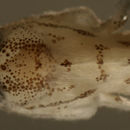fr
noms dans le fil d’Ariane


Description: Transitional recruits develop three short stripes behind the eye with the lowest stripe extending forward of the eye to the tip of the jaw, but notably not continuous under the eyeball (until larger juveniles). Lightly-marked transitional recruits can have only a single melanophore or two at the 7-8 o'clock position on the orbital rim (they have all of the stripes behind the eye). Pigmentation of the body develops more slowly, as a lateral midline row of spots, then an upper body row. The midline spots become X-shaped later. The two colon-like rounded spots at the base of the caudal fin are present early and typically have a linear trail of melanophores onto the fin rays. A chain-like pattern of large deep melanophores develop within the musculature of the tail.
Analogues: The 10/10 sand goby clade share fin-ray counts, morphology, and most markings as larvae and new recruits. C. glaucofraenum and the other head-striped sand gobies develop short stripes on top of the head very early in transition, separating them from the spotted-head gobies (i.e. C. eidolon, C. thrix, C. alloides, C. kuna, and the non-sand Coryphopterus species). C. glaucofraenum diverge early from the other head-striped gobies (C. tortugae, C. bol, and C. dicrus) when they develop colon-like rounded spots at the base of the caudal fin. In addition, they develop melanophores at about 7-8 o'clock on the orbital rim extending straight forward in a stripe (not obliquely down) across the upper jaw vs. a cluster at 6-7 o'clock in C. tortugae and C. bol. In Venezuela, C. venezuelae develops almost identical markings to C. glaucofraenum (but have 11/11 fin elements), diverging only in the juvenile stage.
Diagnosis: Modal fin-ray counts of D-VI,10 A-10 and Pect-18-20 with fused pelvic fins indicate the 10/10 Coryphopterus sand gobies, i.e. Coryphopterus glaucofraenum, C. tortugae, C. bol, C. dicrus, C. eidolon, and C. thrix. Some of the the distinguishing features of adult C. glaucofraenum are not present on recruits and small juveniles.
Coryphopterus glaucofraenum és una espècie de peix de la família dels gòbids i de l'ordre dels perciformes.
Els mascles poden assolir els 8 cm de longitud total.[3][4]
Es troba des de Carolina del Nord (Estats Units) i Bermuda fins a Santa Catarina (Brasil), incloent-hi el Carib.[3]
Coryphopterus glaucofraenum és una espècie de peix de la família dels gòbids i de l'ordre dels perciformes.
Coryphopterus glaucofraenum, the bridled goby, is a species of goby native to the Western Atlantic Ocean and the Caribbean Sea from North Carolina to Brazil. It can be found on reefs at depths of from 2 to 45 metres (6.6 to 147.6 ft) in areas of white sand. This species can reach a length of 8 centimetres (3.1 in) TL. It occasionally makes its way into the aquarium trade.[2]
Coryphopterus glaucofraenum, the bridled goby, is a species of goby native to the Western Atlantic Ocean and the Caribbean Sea from North Carolina to Brazil. It can be found on reefs at depths of from 2 to 45 metres (6.6 to 147.6 ft) in areas of white sand. This species can reach a length of 8 centimetres (3.1 in) TL. It occasionally makes its way into the aquarium trade.
Coryphopterus glaucofraenum es una especie de peces de la familia de los Gobiidae en el orden de los Perciformes.
Los machos pueden llegar alcanzar los 8 cm de longitud total.[1][2]
Se encuentra desde Carolina del Norte (Estados Unidos) y Bermuda hasta Santa Catarina (Brasil), incluyendo el Caribe
Es inofensivo para los humanos.
Coryphopterus glaucofraenum es una especie de peces de la familia de los Gobiidae en el orden de los Perciformes.
Coryphopterus glaucofraenum Coryphopterus generoko animalia da. Arrainen barruko Actinopterygii klasean sailkatzen da, Gobiidae familian.
Coryphopterus glaucofraenum Coryphopterus generoko animalia da. Arrainen barruko Actinopterygii klasean sailkatzen da, Gobiidae familian.
Coryphopterus glaucofraenum is een straalvinnige vissensoort uit de familie van grondels (Gobiidae).[2] De wetenschappelijke naam van de soort is voor het eerst geldig gepubliceerd in 1863 door Gill.
Bronnen, noten en/of referenties